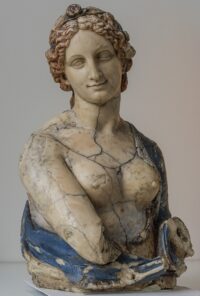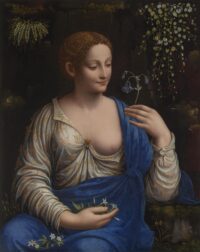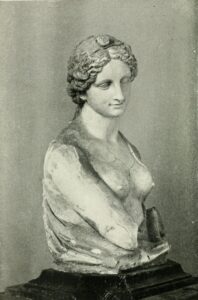A wax bust whose attribution to Leonardo da Vinci once caused art historians to threaten violence has been conclusively shown to be a modern work from the 18th century at the earliest.
 The bust of Flora, goddess of flowers and springtime, now in the National Museums in Berlin was spotted by general director of the Royal Museum of Berlin Wilhelm von Bode in an antique store in London in 1907. Her downcast eyes, half-smile and finely-modeled features impressed Bode as a work by Leonardo da Vinci. German art historian Max Friedländer, assistant director of the Kaiser-Friedrich Museum under Bode, was convinced by its high quality and wear patterns that it was a Renaissance work. Bode bought it for a princely sum (185,000 Goldmark) in 1909 and announced with much fanfare that it was a work by no less a Renaissance luminary than Leonardo da Vinci, the only known wax sculpture surviving from the period.
The bust of Flora, goddess of flowers and springtime, now in the National Museums in Berlin was spotted by general director of the Royal Museum of Berlin Wilhelm von Bode in an antique store in London in 1907. Her downcast eyes, half-smile and finely-modeled features impressed Bode as a work by Leonardo da Vinci. German art historian Max Friedländer, assistant director of the Kaiser-Friedrich Museum under Bode, was convinced by its high quality and wear patterns that it was a Renaissance work. Bode bought it for a princely sum (185,000 Goldmark) in 1909 and announced with much fanfare that it was a work by no less a Renaissance luminary than Leonardo da Vinci, the only known wax sculpture surviving from the period.
Bode was held in high regard in Germany. He had been involved in the creation of a national collection for the royal museums since he was hired as assistant curator of sculpture in 1872 and his career would span the entire five decades of the second German Empire from Unification to Republic. Driven to make Berlin a capital of the arts on the same level with Paris, Vienna, London, St. Petersburg and Rome, he had often been in competition against his counterparts in developing the great public collections of Europe, including a long-standing bitter dispute with Giovanni Morelli, an eminent Italian scholar, parliamentarian and strong advocate against the sale of Italy’s cultural patrimony to deep-pocketed foreign museums, on attribution methodology.
 The acquisition of Flora was seen as a huge coup for Germany’s cultural institutions. The bust had been snatched out from under Britain’s nose and now Germany had a unique work of the world’s most famous and least prolific Old Master. The braggadocio was immediately met with pushback. Within months, the Times published a story contesting the attribution and alleging Flora was in fact it was created by 19th century British sculptor and photographer Richard Cockle Lucas who had copied it in 1860 from a painting of Flora in the Hermitage once attributed to Leonardo but later determined to be the work of his student and right-hand-man Francesco Melzi. Lucas’ son Albert Dürer Lucas, then 80 years old, swore that his father had made it and that Albert had helped stuff old newspapers and wood chips into the hollow of the bust.
The acquisition of Flora was seen as a huge coup for Germany’s cultural institutions. The bust had been snatched out from under Britain’s nose and now Germany had a unique work of the world’s most famous and least prolific Old Master. The braggadocio was immediately met with pushback. Within months, the Times published a story contesting the attribution and alleging Flora was in fact it was created by 19th century British sculptor and photographer Richard Cockle Lucas who had copied it in 1860 from a painting of Flora in the Hermitage once attributed to Leonardo but later determined to be the work of his student and right-hand-man Francesco Melzi. Lucas’ son Albert Dürer Lucas, then 80 years old, swore that his father had made it and that Albert had helped stuff old newspapers and wood chips into the hollow of the bust.
Even though newspapers and wood chips were indeed found inside, including an article from 1840, Bode dismissed out of hand the possibility that Lucas was the sculptor. Lucas, Bode contended, was simply not good enough to model so superlative a piece. Unlike Flora, Lucas’ known wax pieces were greyish in color, lacked any polychromy and still smelled of wax. Bode was sure that at most, Lucas had been employed to fill its empty core to reinforce the structure and had fashioned some arms to match.
In the next two years, more than 730 heated articles were written debating the attribution. There were debates on the floor of the Prussian parliament. Two scholars challenged each other to a duel. Bode died in 1929, still convinced that his attribution to Leonardo was correct. The debate got less aggressive over the decades, but never died down. Even modern technology hasn’t been able to settle the issue conclusively, because wax, as it happens, is a complicated medium to date.
 Albert Dürer Lucas said his father made the bust by melting down a bunch of burned candle ends. Analysis of wax samples found it is composed almost entirely of spermaceti, a waxy substance produced in the head cavity of the sperm whale commonly used in 19th century candles, and a small amount of beeswax. The decay of C14 occurs in the atmosphere in a calculable way, but under water the C14 is absorbed much more slowly and is much older than the carbon absorbed on land. The Marine Reservoir Effect makes radiocarbon dating results difficult to calibrate because you would need to know that specific whale’s full biography — track it movements from equator to ice shelves — to produce any semblance of accurate results.
Albert Dürer Lucas said his father made the bust by melting down a bunch of burned candle ends. Analysis of wax samples found it is composed almost entirely of spermaceti, a waxy substance produced in the head cavity of the sperm whale commonly used in 19th century candles, and a small amount of beeswax. The decay of C14 occurs in the atmosphere in a calculable way, but under water the C14 is absorbed much more slowly and is much older than the carbon absorbed on land. The Marine Reservoir Effect makes radiocarbon dating results difficult to calibrate because you would need to know that specific whale’s full biography — track it movements from equator to ice shelves — to produce any semblance of accurate results.
An attempt to radiocarbon date Flora in the 1980s was able to exclude the Renaissance period, but the results were not reliable as the marine calibration issue remained thorny. The new study utilized two calibration curves, marine and terrestrial, and applied them to samples of the wax from Flora as well as to another work by Lucas, an 1850 relief of Leda and the Swan. The result was a date range of between 1704 and 1950, admittedly wide, but it conclusively precludes that the bust was made by Leonardo or anyone else in the Renaissance.
The study has been published in the journal Scientific Reports and can be read here.